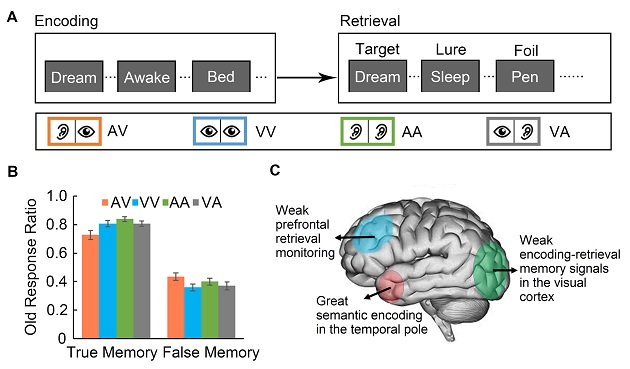On Feb. 14, 2019, PNAS published online the research paper “Multiple interactive memory representations underlie the induction of false memory” by Dr. Bi Zhu and Gui Xue’s lab at Beijing Normal University, in collaboration with Chuansheng Chen and Elizabeth F. Loftus at the University of California, Irvine. This study disclosed the role of encoding-retrieval neural interactions in false memory.
Memory is not perfect, and false memories appear frequently in our daily life. For example, after studying a list of words (e.g., “Dream”, “Awake”, “Bed”, and so on), we often recognize unstudied but semantically related lures (e.g., “Sleep”) as old (i.e., false memory), although rarely recognize the unstudied and unrelated foils (e.g., “Pen”) as old (Fig 1A). More interestingly, there is also a Chinese idiom that says, “Hearing is vague, seeing is believing.” Indeed, auditory learning and visual test resulted in more false memories, as compared with other three combinations of sensory modalities during learning and test (Fig 1B). Perhaps not coincidentally, most previous misinformation studies that created high rates of false memories also asked people to hear the misinformation after seeing the original event.
Dr. Zhu and Xue’s lab has long been interested in understanding how memory is formed in the brain. Their early work suggests that memory is not only dependent on the neural processes during encoding and retrieval, but also on the complex interactions of memory representations between encoding and retrieval, as well as on the interaction between the tested events and all other events in the episodic memory space (i.e., global matching) (Davis et al., 2014, JN; Xiao et al., 2016, Cortex; Ye et al., 2016, JN; Xue, 2018, TICS). As shown in our previous studies, individual differences in false memory are related to visual-auditory abilities, sensory-related brain structures, and neurotransmitter genetic variants (Zhu et al., 2010, Memory; Zhu et al., 2013; NLM; Zhu et al., 2016, BSF). However, it is still unclear (1) why auditory learning and visual test resulted in more false memories than other combinations of sensory modalities, and (2) what role encoding-retrieval neural interactions play in false memories.
In this study, using sophisticated neural representation analysis of fMRI data, we found that this effect was jointly related to three neural mechanisms: Compared with the visual learning and visual test condition, auditory learning and visual test showed (i) weaker memory signals in the visual cortex, (ii) reduced prefrontal monitoring, and (iii) a greater reliance on semantic encoding during learning. These results highlight the complex interactions of memory representations during learning and test that give rise to the appearance of false memories. Our findings not only help to advance a more mechanistic understanding of the reconstructive nature of memory, but also have important practical implications for our educational, clinical, and legal practices.
This work was sponsored by the National Natural Science Foundation of China and the 973 Program.
Paper website: www.pnas.org/cgi/doi/10.1073/pnas.1817925116
Zhu, Bi, Chen, Chuansheng, Shao, Xuhao, Liu, Wenzhi, Ye, Zhifang, Zhuang, Liping, Zheng, Li, Loftus, Elizabeth F., and Xue, Gui. (2019). Multiple interactive memory representations underlie the induction of false memory. Proceedings of the National Academy of Sciences, 201817925. doi: 10.1073/pnas.1817925116.

Fig 1. An illustration for the experimental procedure, behavioral results, and the neural basis of false memory. (A) Experimental procedure. After studying a list of words, participants were asked to make memory judgement on three types of words (i.e., targets, lures, and foils). There are four conditions, including auditory learning visual test (AV), visual learning visual test (VV), auditory learning auditory test (AA), and visual learning auditory test (VA). (B) Behavioral results. The corrected true memory (i.e., the endorsement rate of targets judged as old minus that of foils judged as old) and corrected false memory (i.e., the endorsement rate of lures judged as old minus that of foils judged as old). (C) An illustration for the neural basis of false memories under the AV condition as compared to the VV condition.
Other related papers:
Xue, G. (2018). The neural representations underlying human episodic memory. Trends Cogn Sci, 22, 544-561.
Davis, T., Xue, G., Love, B. C., Preston, A. R., & Poldrack, R. A. (2014). Global neural pattern similarity as a common basis for categorization and recognition memory. J Neurosci., 34, 7472-7484.
Xiao, X., Dong, Q., Chen, C., & Xue, G. (2016). Neural pattern similarity underlies the mnemonic advantages for living words. Cortex, 79, 99-111.
Ye, Z., Zhu, B., Zhuang, L., Lu, Z., Chen, C., & Xue, G. (2016). Neural global pattern similarity underlies true and false memories. J Neurosci., 36, 6792-6802.
Zhu, B., Chen, C., Loftus, E. F., He, Q., Lei, X., Dong, Q., & Lin, C. (2016). Hippocampal size is related to short-term true and false memory, and right fusiform size is related to long-term true and false memory. Brain Structure and Function, 221, 4045-4057.
Zhu, B., Chen, C., Loftus, E. F., Lin, C., He, Q., Chen, C., Li, H., Xue, G., Lu, Z. & Dong, Q. (2010). Individual differences in false memory from misinformation: Cognitive factors. Memory, 18, 543-555.
Zhu, B., Chen, C., Loftus, E. F., Moyzis, R. K., Dong, Q., & Lin, C. (2013). True but not false memories are associated with the HTR2A gene. Neurobiology of Learning and Memory, 106, 204-209.
(Bi Zhu wrote this news report for the BNU lab website on Feb. 18, 2019)
